...
| Tip |
|---|
| See this document for TLS configuration: Configuring Secure MQTT Communication |
- CA Certification Certificate File
- CA Certification Certificate file currently in use.
- Client Certification Certificate File
- Client Certification Certificate file currently in use.
- Client Private Key File
- Client Private Key file currently in use
- Change Password?
- Check box to enable changing of the optional password.
- Password
- Optional password associated with the certificate's private key.
- Hostname Verification
- Enable TLS Hostname Verification. This is true by default.
- TLS ALPN Extensions
- Optional TLS ALPN Extensions to use with this connection
...
- Client ID
- Keep Alive
- The maximum interval in seconds (5-65,535) between any two MQTT protocol control packets sent by the client to the server.
- The minimum Keep Alive for MQTT Transmission is 5.
- If the client is idle and has no control packets to send, it will send PINGREQ protocol packet and the server is required to respond with a PINGRESP packet. If no response is received from the server within 1.5 times the Keep Alive, the client will close the connection.
If the server does not receive, at minimum, a PINGREQ message from a client within 1.5 times the Keep Alive, it will terminate the connection and send the client's LWT if it has been defined.
For MQTT Transmission, this is an DEATH message.
- Random Startup Delay
- The Random Startup Delay in milliseconds of the form 'min-max' where min is the low end and max is the high end of the random range. e.g. '10-1000'.
- Reconnect Delay
- The clients reconnect delay in millisecond.
- Subscribe to Legacy STATE Topic
- Data Format Type
- The format of the data to send. Default is Sparkplug_B_v1_0_Protobuf with JSON as an option.
| Anchor |
|---|
| ServerSettingsRPCClient |
|---|
| ServerSettingsRPCClient |
|---|
|
Server Settings - RPC Client Connection
...
- Enable/disable RPC Client
- Auto-reconnect RPC Client
- If checked, the RPC client will automatically reconnect to the server.
- If unchecked, the RPC client will try to connect at publish time
- RPC Client ID
- A manually configured MQTT Client ID for this RPC connection
- Do not use this setting unless it is an absolute requirement that a specific Client ID be used for the connection to the MQTT Server. If left blank, one will be auto-generated.
- Username
- Optional username for this RPC connection if required by the MQTT Server
- Password
- Optional password for this RPC connection if required by the MQTT Server
- CA Certification File
- CA Certificate file currently in use
- Client Certificate File
- Client certificate file currently in use
- Client Private Key File
- Client private key file currently in use
- Password
- Optional password associated with the certificates private key
- Hostname Verification
- Enable hostname verification. Enabled by default
- TLS ALPN Extensions
- Optional TLS ALPN Extensions to use with this connection
...
| Anchor |
|---|
| TransmittersAlarmSettings |
|---|
| TransmittersAlarmSettings |
|---|
|
Transmitters - Alarm Settings
| Tip |
|---|
| Available in MQTT Transmission 4.0.16 and newer |

...
| Anchor |
|---|
| TransmittersAdvancedSettings |
|---|
| TransmittersAdvancedSettings |
|---|
|
Transmitters - Advanced Settings
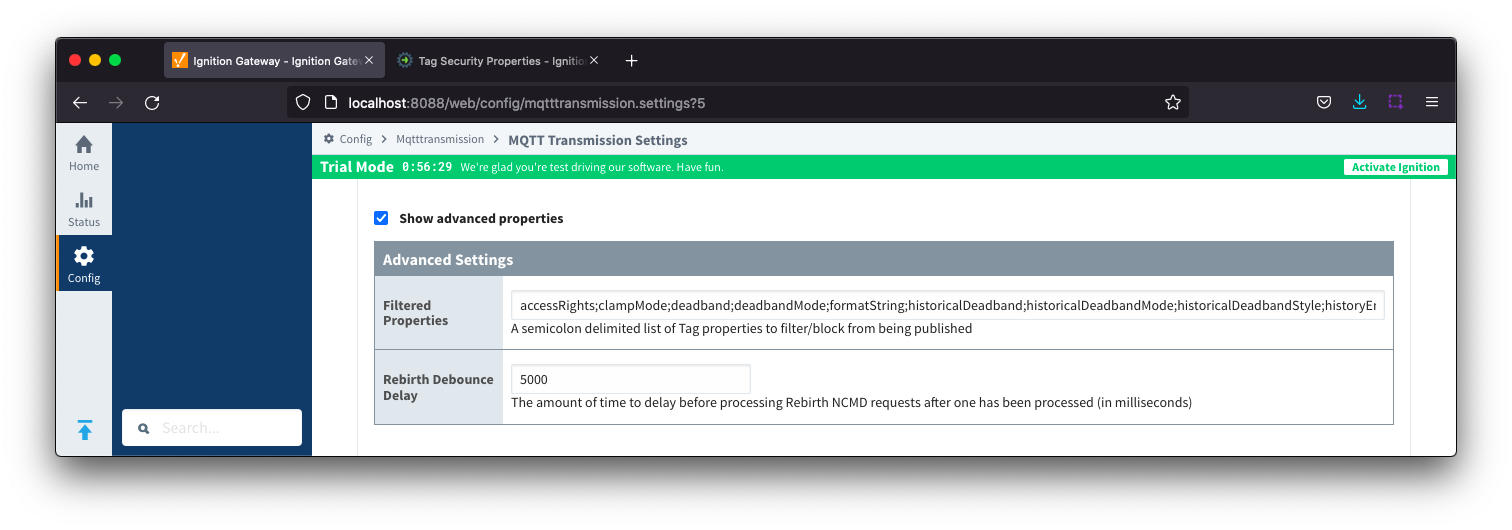 Image Removed
Image Removed Image Added
Image Added- Filtered Properties
- Rebirth Debounce Delay
- The amount of time, in milliseconds, to delay before processing Rebirth NCMD requests after one has been processed. Default of 5000 milliseconds.
- Include Sparkplug DataTypes
- Whether or not to include Sparkplug DataTypes for Metrics in Sparkplug DATA payloads
- Enabled by default
Records
...
The configuration sections available are Tag Settings, Sparkplug Settings, Records Signature and Advanced Settings.
| Anchor |
|---|
| RecordsTagSettings |
|---|
| RecordsTagSettings |
|---|
|
Records -
Tag Settings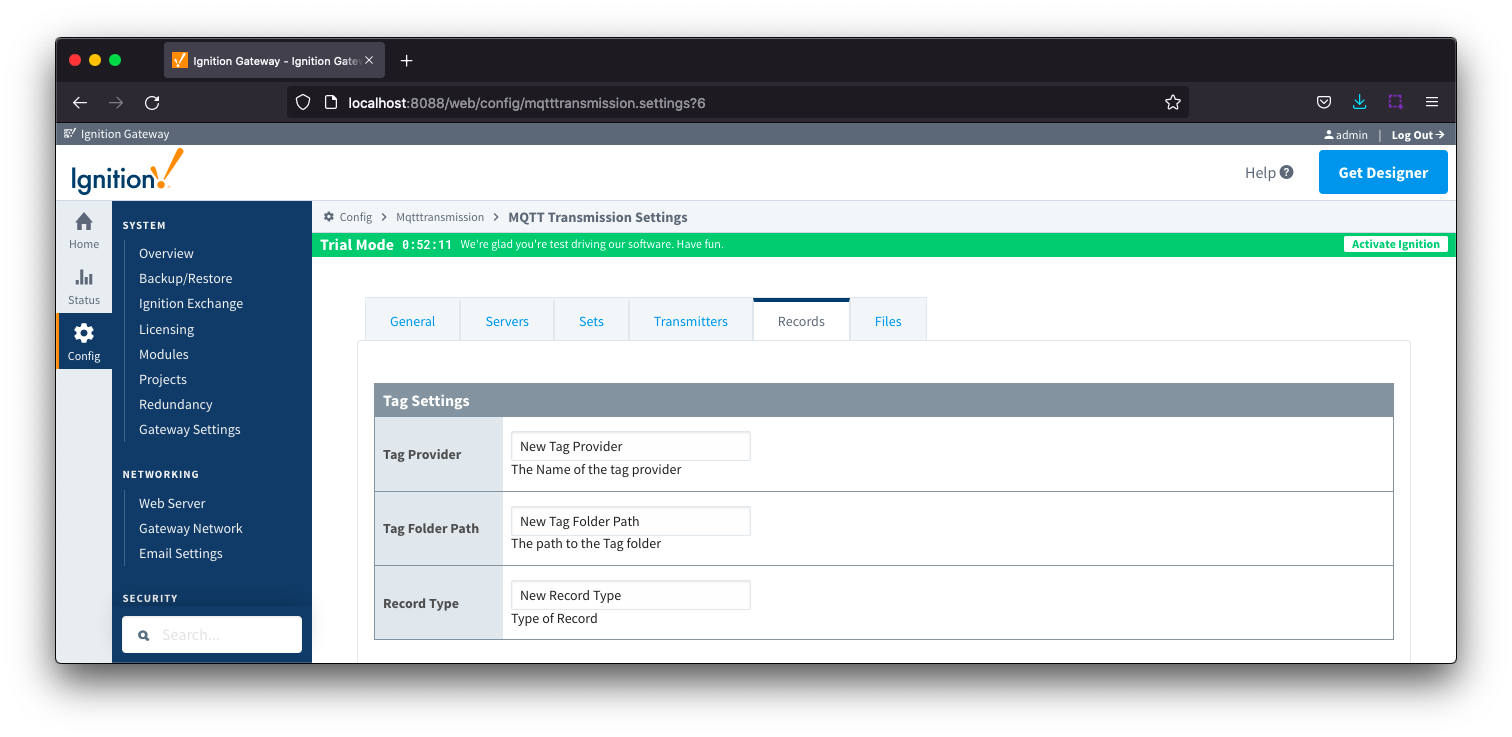
...
- Group ID
- The Group ID that matches an existing Sparkplug Edge Node.
- Edge Node ID
- The Edge Node ID that matches an existing Sparkplug Edge Node.
- Device ID
- The Device ID that matches an existing Sparkplug Edge Node. (Optional)
...
...
Records - ...
Records Signature
| Note |
|---|
| From version 4.0.19 added support for digital signatures/hashing of Records that are generated by MQTT Transmission so that they can be verified in the MQTT Recorder database. |
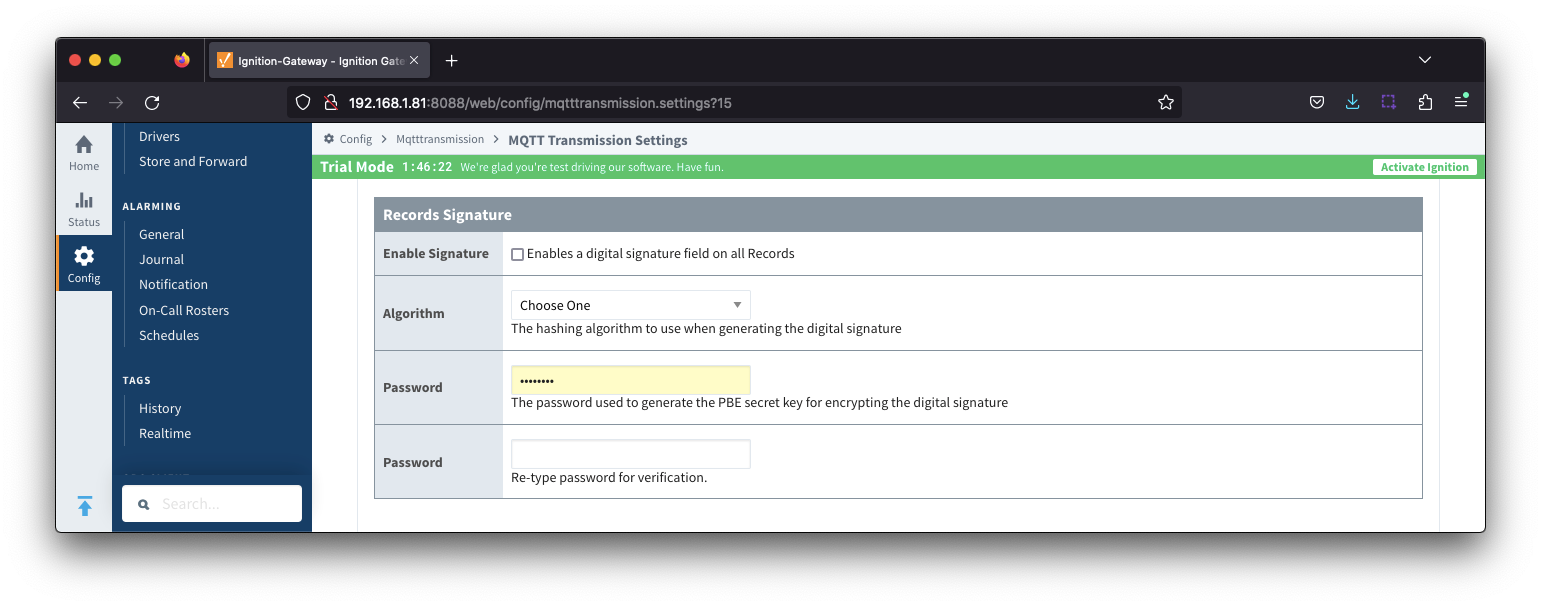 Image Added
Image Added
- Enable Signature
- Checkbox to enable a digital signature field on all Records. Default is de-selected
- Algorithm
- The hashing algorithm to use when generating the digital signature
- Options are SHA_1,SHA_224,SHA_256,SHA_384 and SHA_512
- Password
- The password used to generate the PBE secret key for encrypting the digital signature
| Anchor |
|---|
| RecordsAdvancedSettings |
|---|
| RecordsAdvancedSettings |
|---|
|
Records - Advanced SettingsEach record will have an associated boolean tag that is used to trigger the on demand publish of the record. The Advanced settings manage the location and naming of this boolean tag. Image Added
Image Added
- Override Publish Tag
- When unchecked, the tag used to control the record publish will be created within the record defined folder path and named "Publish"
- When checked, the tag used to control the record publish will be created using the Publish Tag Path property
- Publish Tag Path
- Defines the tag path for the boolean tag used to control the record publish
Each record will have an associated boolean tag that is used to trigger the on demand publish of the record. The Advanced settings manage the location and naming of this boolean tag. Image Removed
Image Removed
- Override Publish Tag
- When unchecked, the tag used to control the record publish will be created within the record defined folder path and named "Publish"
- When checked, the tag used to control the record publish will be created using the Publish Tag Path property
- Publish Tag Path
- Defines the tag path for the boolean tag used to control the record publish
- This can be used to create a tag in the record defined file folder with an alternate name to "Publish" or to have the tag located in a separate folder
- The full tag path, including the tag provider, needs to be used for example: [default]Edge Nodes/G1/E1/RecordControl/PublishEvents or [default]Edge Nodes/G1/E1/D1/Alarm/PublishAlarms
...
When a Transmitter is configured to use an MQTT Transmission History Store, data is written to the History Store once MQTT Transmission has determined that there is a connection failure. Once a connection with an MQTT server is re-established the History Store will publish the stored messages with a flag set to indicate that the messages are "historical" to prevent confusion with live data values. Determination of a connection failure can be up to 1.5 times the configured keep alive. and, as such, any data published during this time can be lost.
| Note |
|---|
| From release 4.0.17, in order to cover data loss during a keep alive timeout scenario, the MQTT Transmission History Store includes a Rolling History Buffer that can be configured in the Advanced Properties configuration section. When the Rolling History Buffer is enabled, all tag changes will be written to the History Store regardless of connection status. |
 Image Removed
Image Removed
The History tab contains a Main section and an Advanced section.
| Note |
|---|
| From release 4.0.19, major improvements have been made to the disk-backed History Store. Details on configuring pre 4.0.19 modules can be found here. |
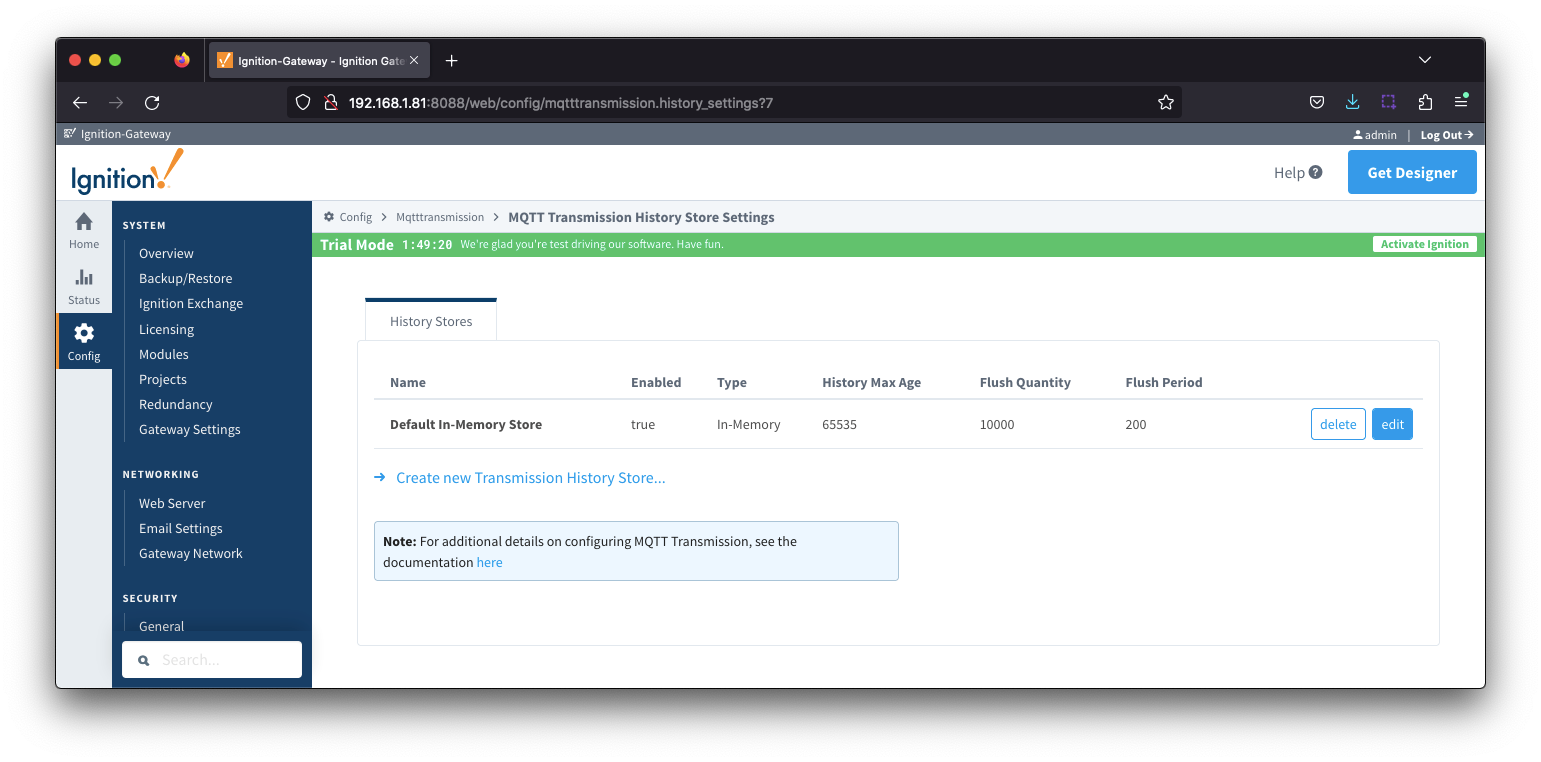 Image Added
Image Added
The History tab contains a Main section and an Advanced section.
History - Main Image Removed
Image Removed
...
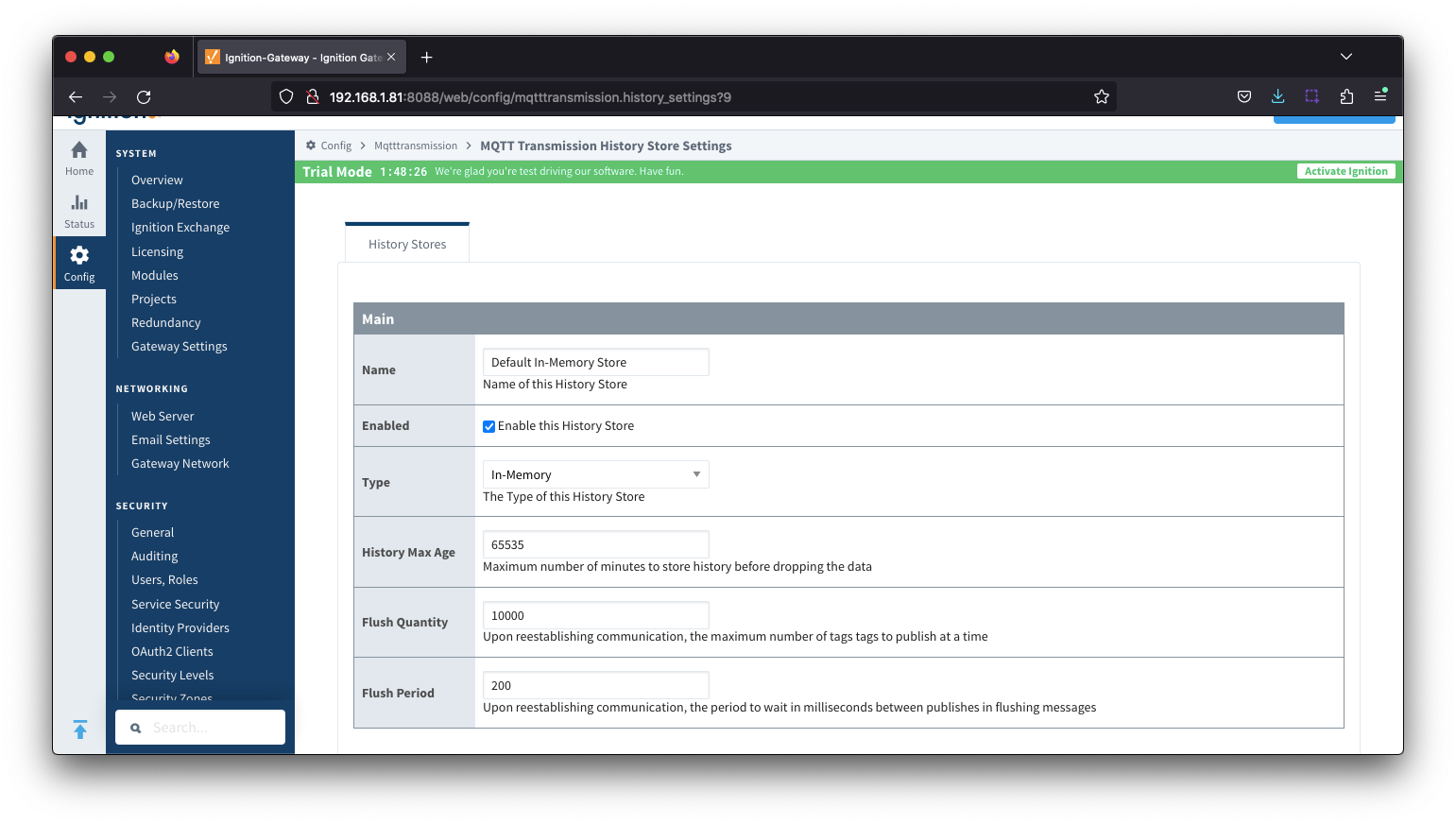 Image Added
Image Added
...
- Name
- The name of the History Store.
- Enabled
- Checkbox to enable/disable the History Store. Not selected by default.
- Type
- The type of History Store.
- Data stored in an In-Memory History Store will not be persisted across a module configuration change, module disable/enable, module restart or power loss.
- Data stored in a Disk-Backed History Store will persist across a module configuration change, module disable/enable, module restart or power loss.
- History Max Age
- Maximum number of minutes to store history before dropping the data
...
| Info |
|---|
| title | Large Tag Capacities |
|---|
|
If using a large tag capacity it is highly recommended to test the system under load in a non-production environment on similar hardware and software that will be used in production. During testing is also important to get the system into a state where the store and forward cache becomes full before beginning to flush. This will ensure that the system is sized appropriately when deployed into a production environment. There are a number of factors involved in determining how large the tag capacity can be including but not limited to system resources such as CPU, RAM (especially when using 'In-Memory'), Disk IOPS (if using 'Disk-Backed'), the nominal tag change rate (e.g. number of tags changing per second in the system), the flush rate, bandwidth availability, whether flushing in order vs asynchronously, etc. Because of the complex interactions of these variables it is highly recommended to test in a controlled environment. Generally any capacity over 2,000,000 is considered large and should be tested before deploying to production. Review Determining the settings for an MQTT Transmission History Store |
- Name
- The name of the History Store.
- Enabled
- Checkbox to enable/disable the History Store. Not selected by default.
- Type
- The type of History Store.
- Data stored in an In-Memory History Store will not be persisted across a module disable/enable, module restart or power loss.
- Data stored in a Disk-Backed History Store will persist across a module disable/enable, module restart or power loss.
- Edge Node Tag Capacity
- Maximum number of Edge Node level tag change events to store per Edge Node before dropping oldest historical Edge Node tag change events. This value is independent of the 'Device Tag Capacity' and only applies to how many 'Edge Node level' tag change events are stored per Edge Node.
- A tag change event is triggered by either a change in value or quality and results in the tag's Qualified Value (which has three attributes of value, quality and timestamp) being stored.
- Device Tag Capacity
- Maximum number of Device tag change events to store per Device before dropping oldest historical Device tag change events. This value is independent of the 'Edge Node Tag Capacity' and only applies to how many 'Device level' tag change events are stored per Device.
- A tag change event is triggered by either a change in value or quality and results in the tag's Qualified Value (which has three attributes of value, quality and timestamp) being stored.
- Flush Quantity
- The maximum number of tags to publish in a single message upon reestablishing communication.
- Flush Period
- The period to wait in milliseconds between publishes when flushing messages upon reestablishing communication
| Anchor |
|---|
| HistoryAdvanced |
|---|
| HistoryAdvanced |
|---|
|
History - Advanced
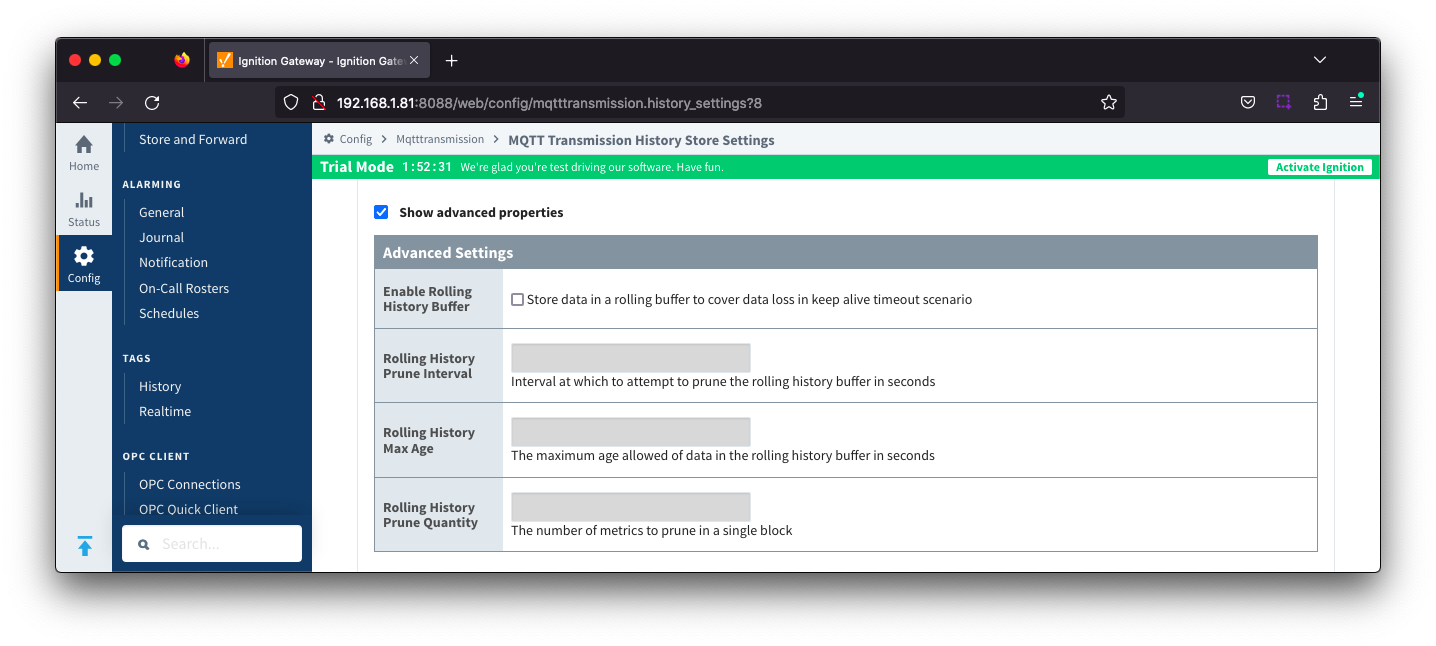 Image Removed
Image Removed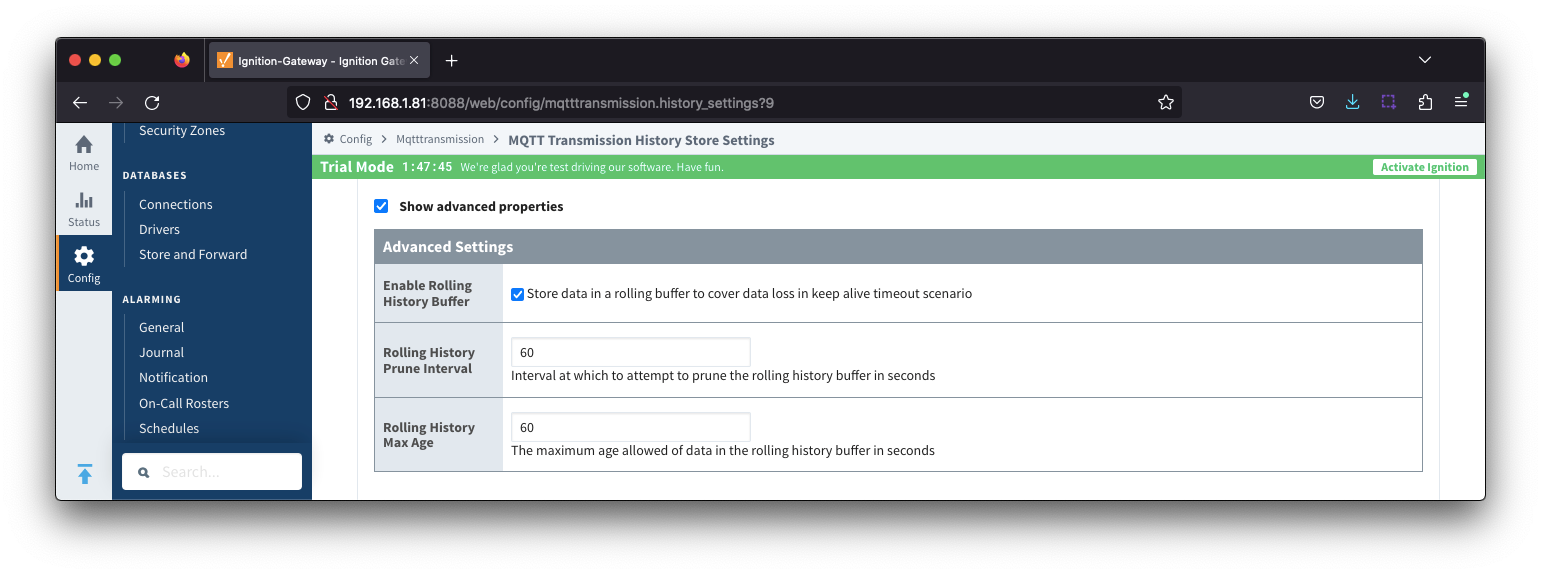 Image Added
Image Added
- Enable Rolling History Buffer
- Enable/disable storing data in a rolling buffer to cover data loss in Keep Alive timeout scenario
- Rolling History Prune Interval
- The interval, in seconds at which to attempt to prune the rolling history buffer
- Rolling History Max Age
- The maximum age allowed of data, in seconds, in the rolling history buffer
- This should be at least 2 x the Keep Alive timeout
Rolling History Prune Quality- The number of metrics to prune in a single block
![]()
![]()
![]()
![]()
![]()
![]()
![]()
![]()
![]()